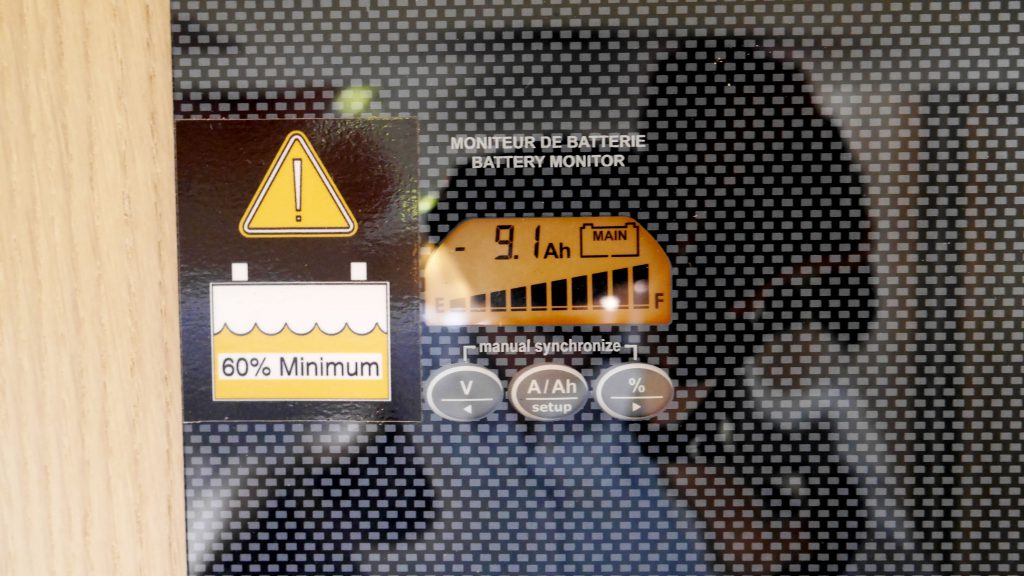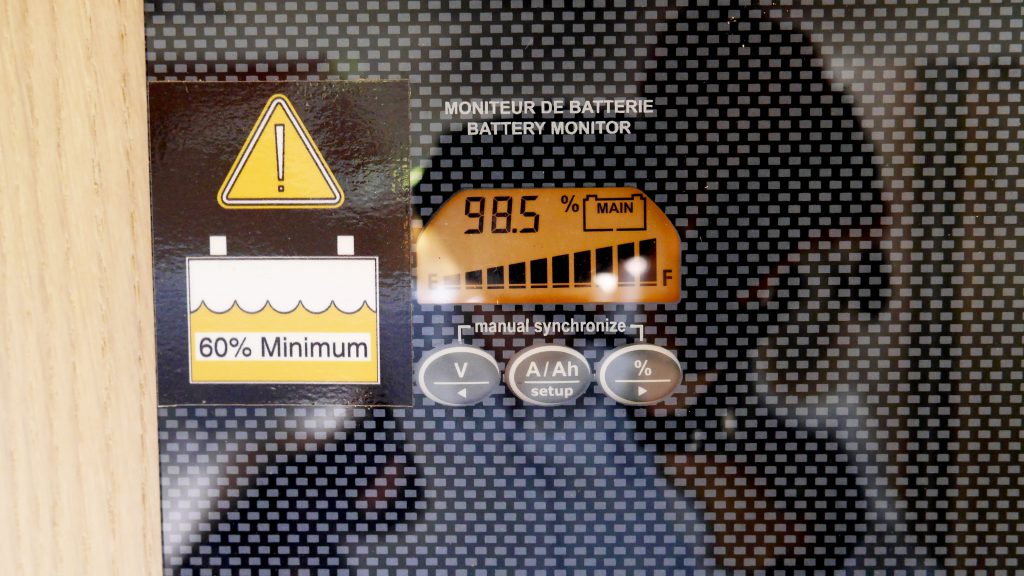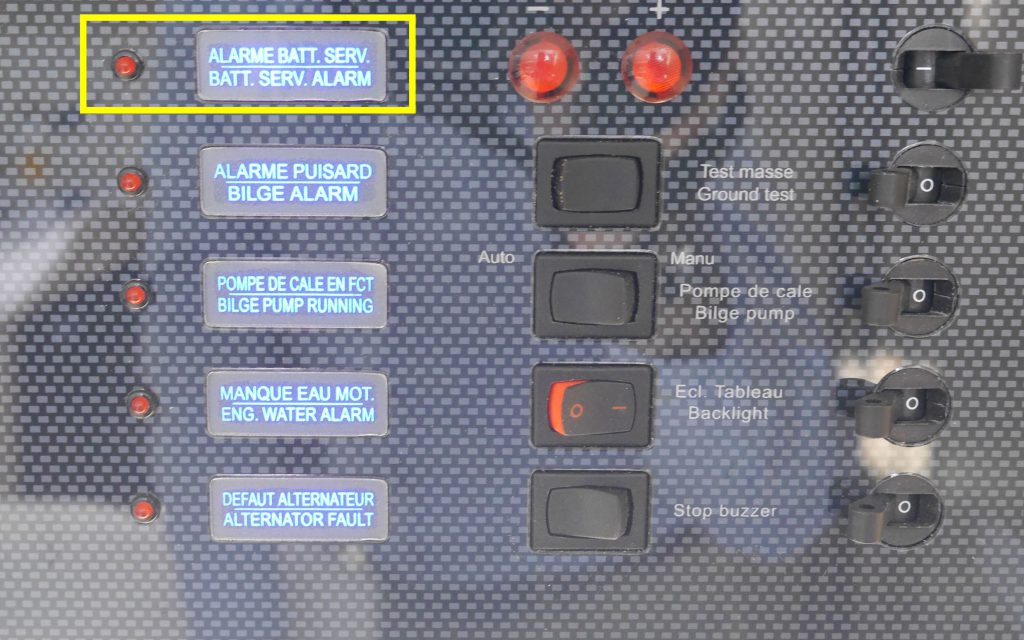Checking and charging the service batteries
The “Daily activities” guides are aimed either at the owner of a newly acquired boat or to crewmembers and guests needing to familiarise themselves with the operation of the AMEL. As such simple day-to-day actions, such as “An expresso please ! ” or “Setting the AMEL 55 in the departure configuration ”, will be dealt with here. The daily use and monitoring of the AMEL 55 service battery set, an essential part of the boat, will also be covered.
The service battery set supplies the 24V current on-board. It is this current which powers the lighting, engine start, the electronics, the fresh water circuit, and the toilets, amongst other things. However, this energy is not infinite and it is necessary to constantly monitor the battery level on the boat. When using the 24V electrical equipment on-board it is necessary to ensure that the batteries can be recharged to the level at which they were before.
Checking the service battery set level :
A voltmeter is available on the 24V Switchboard of our boats. It shows:
- The voltage of the batteries at that particular moment,

- The consumption in amps at that particular moment

- The consumption in Ah (amps per hours) as of when the batteries have topped charging

- The battery charge level as a percentage.

For example, on the previous series of photos, it can be seen that the service battery set of this boat displays:
- A voltage of 25.8V, which is normal for new batteries
- An real-time consumption of 4.8A, which probably corresponds to lighting
- A discharge of 9.1 Ah since the last recharge
- A charge rate of 98.5%, indicating that the batteries are almost fully charged.
There is no pressing action to perform in this case.
The most useful information on a daily basis is the charge rate of the batteries as a percentage. In the case of gel batteries, which are now installed on our boats, these can bear a discharge of 40%. This means that the multi-meter will then display a charge rate of 60%. Beyond this the service life of the batteries is in danger. Action must be taken! The same logic applies to other types of battery (e.g. AGM). All that needs to be known is the discharge rate that the relative set supports. If in doubt, do not let the battery charge fall below 85%.
In the event that this is forgotten or a mistake is made, a low-voltage alarm sounds. A red indicator light accompanied by an audible alarm will sound as soon as the voltage of the battery set reaches 24 Volts (photo below).

However it is important to be aware that this alarm can also warn that the battery set is too high. If this is indeed the case all charging equipment must be stopped. In order to know what to do if this alarm sounds it is necessary to take the time to check the battery voltage on the voltmeter in order to be sure that they do indeed need to be charged.
Recharging the service battery set :
There are actually 3 ways to recharge the service battery set. It can be done using:
- 110A and 60A chargers which use current from the dock or the electrical generator set
- The engine and its 24V 110A alternator.
It is also possible to use both chargers simultaneously (via the dock or the electrical generator set) to the engine. The charger and the alternator automatically adjust themselves electronically.
It should be noted that our boats can charge the batteries even if the switches are off.
Charging using the dock plug :
- Obviously the boat must be connected to the dock and it must be ensured that the terminal is delivering current. To do this follow the instructions in the article “Daily actions : Connecting your Amel to the shore power“
- Ensure that the boat can receive the current. If not, is the circuit breaker of the stern 230V box engaged? Is the switch on the 230V Switchboard in the kitchen ON? Are live and neutral inverted (red light on the 230V Switchboard)?
- Once the current is available, a green indicator light “Dock voltage” at the top of the 230V Switchboard lights up (fig. 1). Ensure that the dock switch is in the ON position (fig. 2). The voltage level must then be displayed on the voltmeter of the 230V electrical Switchboard (fig. 3).

- The charger(s) can then be turned on (box 4 in the photo above). If the dock trips this could mean that the 2 chargers are drawing too high a current for the dock. This could happen in certain older ports. In this case it is necessary to reset the electrical terminal, re-do the checks from the start and then only use the smaller charger (the second one) to avoid overloading the dock.
- It is possible to check whether the batteries are charging by checking whether the voltmeter of the 24V Switchboard indicates a positive amperage at that particular moment.
Charging using the Genset :
- It is first of all necessary to start the electrical generator set. See the “DAILY ACTIONS: STARTING YOUR ELECTRICAL GENERATOR SET” article
- Once the electrical generator set has been started and its current is stabilise on the 230V Switchboard voltmeter all the chargers can be engaged.
- If the 24V Switchboard voltmeter displays a positive amperage at that particular moment this indicates that the batteries are being charged.
Charging using the engine :
- Starting the engine is all that is required in this case (See the “DAILY ACTIVITIES: STARTING THE ENGINE” article) and rev it up to at least 1000 rpm (indicative value). Then check the “alternator charging fault” red indicator light on the 24V switchboard. If it turns off and if the amperage of the batteries at that moment increases, this indicates that the alternator is working properly. Note however, that at 1000 rpm, the charge rate obtained is quite low.
- It is possible to use the engine alternator without the propeller turning. Simply disengage the clutch and rev the engine. To do this press the button “throttle only” before revving. Be careful however re-engage the clutch once the charging is complete.
When sailing with the sail, or when moored, the most frequent is to start the electrical generator set. As indicated, it may be necessary to run it for several hours a day to make up for its consumption. We recommend dividing this time into 3 and carrying out charging in 3 phases in order to always have a large reserve of power. In case of difficulties starting the electrical generator set, or your engine, there is sufficient power remaining to react and to preserve the service life of your batteries. Generally, we recommend running the electrical generator set for about 1h in the morning, 1h at midday and 1h in the evening.
Here solar panels and the boats like the 64, which have 2 different battery sets, have not been taken into account. The procedure is relatively similar however; it simply requires monitoring of two sets of batteries
To go further :
Let take the example of the AMEL 55 version 2016 to understand how to evaluate the amount of available power on-board.
An AMEL 55 is equipped with 6 200A 12-volt gel batteries. First of all these batteries are put in series of pairs to obtain 24V. The pairs are then mounted in parallel to double up their amperages. Therefore 600A at 24V can be obtained.
With a gel battery 40% of its capacity can be used. If it falls below 60% of its maximum capacity its service life is shortened and tit must be changed much more often. On-board there is therefore 40% of 600A at 24V.
Under normal circumstances an AMEL 55 consumes about 25A per hour. There is therefore 240/25 = 9.6 h of use possible before the batteries must be recharged.
The problem can be looked at from another angle, starting, for example, with the rated power of the equipment to determine the amount of power necessary. Let us take the extreme case of the 10.8HP side thruster. It has a rated power of 8kW (as 1kW = 1.36 Horsepower). To operate at 24V the thruster therefore requires 8kW from the battery set. 1 watt being the product of the voltage (V) and the current in Amps (A), we can deduce that our batteries will supply a current of 8000/24 = 333A.
This makes it easier to understand why such a large battery set is necessary and why it is highly recommended to operate the electrical generator set and the two chargers using the thruster.





